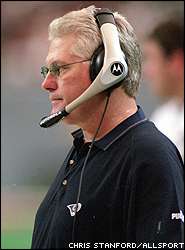Thursday, October 12
Rams' master plan wasn't by design
By Chris Mortensen
Special to ESPN.comIt would be a wonderful story to say that the Rams' offense -- arguably the most explosive in the history of the game -- was all by planning and design.
It's just not the truth. It is that aged formula of planning + design + luck = dynamite. OK, I know I must have flunked physics on this one, but you get the picture.
 | |
| Mike Martz wasn't Dick Vermeil's first choice as offensive coordinator. Mike White was. |
Mike Martz also wasn't Dick Vermeil's first choice as offensive coordinator last year. In fact, Vermeil wanted to promote tight end coach Mike White from his own staff to the position, but Rams president John Shaw wouldn't have it. Shaw got Vermeil focused on somebody who could restore Isaac Bruce to Pro Bowl form; the natural choice was Martz, who had been the Rams receivers coach under Rich Brooks prior to joining Norv Turner in Washington when Vermeil succeeded Brooks in St. Louis.
Nevertheless, Vermeil did pull the trigger on some critical moves during the '97, '98 and '99 drafts that indisputably put the pieces in place.
Vermeil was bold enough in his first year to trade into the New York Jets' No. 1 draft slot in '97 so he could select Ohio State offensive tackle Orlando Pace. The Rams had a Pro Bowl left tackle to protect their passer, whoever it was, for at least the next 10 years.
Vermeil also knew where the game was headed as he spent 17 years as a college TV analyst between NFL jobs -- in fact, it was full speed ahead.
In the '98 draft, where Vermeil sought speed for his receiving corps and special teams. He chose San Diego State's Az-Zahir Hakim in the fourth round, and convinced Tony Horne, an undrafted free agent from Clemson, to climb on board.
Vermeil was almost fired after the '98 season but a series of meetings with Shaw and owner Georgia Frontiere produced some powerful results. Tony Banks was out as quarterback. Offensive coordinator Jerry Rhome was fired (ironically, Rhome had unsuccessfully tried to convince Vermeil to bench Banks in favor of Warner during the '98 season). Martz was hired. Green was signed, having worked with Martz, who was the Redskins QB coach.
Vermeil was flexible enough to make the changes, but he was stubborn on one point -- he was adamant that his personnel plan was designed for a third-year jump. Was he ever right.
The '99 draft was beautifully orchestrated but needed some good fortune. In this case, the Indianapolis Colts felt star running back Marshall Faulk would become a contractual disaster and dealt him away for the Rams' second- and fifth-round picks. The Colts had sought a first-rounder for Faulk but other teams, including the Rams, would not budge. Imagine if somebody else had.
| “ | Kurt Warner? That's what I asked incredulously of Vermeil. Honestly, I barely knew he existed. ” | |
Vermeil and Martz also deserve credit for one other critical decision. When Green went down with the knee injury in the last preseason game one year ago, they did not panic. They discussed quarterback options, and eventually signed Paul Justin as a reserve.
However, I can specifically remember Vermeil telling me, "Mike Martz and I think Kurt Warner gives us the best chance to win, so we're not going to do anything dramatic."
Kurt Warner? That's what I asked incredulously of Vermeil. Honestly, I barely knew he existed.
Vermeil did say that if Warner flopped early in the '99 season, there was a chance the Rams would make another move, perhaps a trade, or simply turn to Justin. Warner never flopped.
Vermeil also crystallized Warner's greatest trait.
"He hits the open receiver," said Vermeil in simplistic terms. "And we have a lot of receivers who get open."
Chris Mortensen covers the NFL for ESPN and ESPN.com.
Copyright ©2000 ESPN Internet Ventures. Terms of Use and Privacy Policy and Safety Information are applicable to this site.